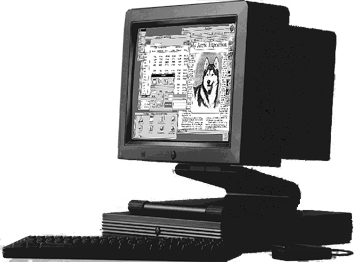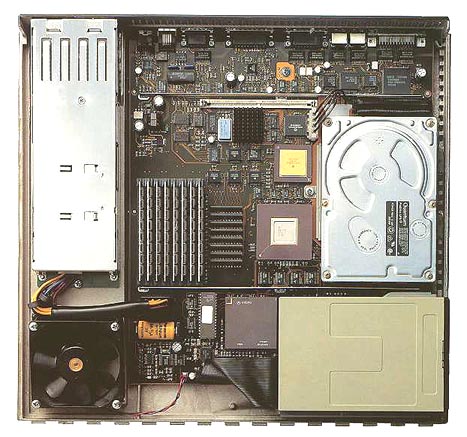NeXT Monochrome "Slab"

Overall, the NeXT computers are among the coolest looking machines ever built. When Steve Jobs left Apple Computer in the mid '80's, he formed NeXT, promising to do with this machine everything he had really wanted to do with the Macintosh. And, for those of you in "the Cult of Steve", he succeeded, creating a revolutionary machine that had a slick user interface, true multitasking, Postscript display, and advanced multimedia capabilities, wrapped in an awesome package - a black computer so stylish, that it was often used as a futuristic prop in Movies and Music Videos.
While many at the time thought that Steve had created "the next great thing", the machine did not attract the support of some software developers, so critically important applications for wide acceptance of the machine never materialized, and eventually the hardware arm of NeXT disappeared, leaving a software company to continue to develop the NeXTstep OS (which has been ported to a variety of platforms). This company was eventually sold to Apple (ironic in the extreme), and Jobs returned to Apple, and helped create the iMac, which boosted Apple from near failure to Wall Street Wunderkid again.
Despite all this, the NeXT machines, particularly the original "Cube" systems, are highly prized by collectors interested in having a great looking piece of hardware that, despite it's age, are still very capable as a desktop workstations.
In 1991, NeXT introduced a low-priced NeXTstation, in a pizza-box configuration. Called "The Slab" by NeXT, this machine had a single half-height hard drive, a 2.88 MB floppy drive, a short custom monitor cable, and the familiar 17" monochrome screen. There was no room for internal expansion (i.e., no card slots), and only 32 MB of 4 Mb 30-pin SIMMs, as opposed to 64 MB on the motherboard of a cube.
NeXT Monochrome Slab Hardware Info
CPU: 25MHz Motorola 68040 (note that the "Turbo" models used a 33Mhz 68040)
DSP: 25MHz DSP56001
Audio: 16bit 8 channel stereo in/out
Memory IC: TMC (Turbo Memory Controller)
Control ICs: Peripheral Controller controls 7 DMA channels
Floppy drive: 2.88 megabyte, which required Extended Density diskettes - Note, however, that the drive can read and write Macintosh and PC 1.44MB (and probably 720k as well) diskettes.

 One of the reasons the Slab is able to seem so minimal is that some of the components are inside the monitor and "shared" by the computer. For example, the Slab contains no power switch, keyboard connector, or any multimedia functionality -- instead, all that is carried in and out of the computer by the 19pin cable between the Slab and the Monitor.
One of the reasons the Slab is able to seem so minimal is that some of the components are inside the monitor and "shared" by the computer. For example, the Slab contains no power switch, keyboard connector, or any multimedia functionality -- instead, all that is carried in and out of the computer by the 19pin cable between the Slab and the Monitor.
 Looking at the back of the slab, it's apparent how much is shared between the monitor and the main unit - in fact, the monitor doesn't even have it's own power connection -- again, everything is carried through the DB19 connector. The keyboard connects to the monitor, the monitor to the computer, and the power switch is on the keyboard!
Looking at the back of the slab, it's apparent how much is shared between the monitor and the main unit - in fact, the monitor doesn't even have it's own power connection -- again, everything is carried through the DB19 connector. The keyboard connects to the monitor, the monitor to the computer, and the power switch is on the keyboard!
On the interior it's also clean and minimal. Starting from the top of this image down are the rear ports and power supply, the memory, LSI chip, and HD, and the fan, CPU and floppy drive. On my personal machine, the CPU has a heatsink, I see on this image that it doesn't have one. Curious.
The memory on a non-turbo monochrome slab is 30-pin SIMMs, of either 1 or 4MB. The ram is divided into 2 banks of 4 SIMMs and you can mix densities as long as each bank is of the same density. In other words, you can have a 20MB Slab with "bank one" being four 4MB SIMMs and "bank two" being four 1MB SIMMs. The maximum ram a standard slab can take is 32MB. Personally I feel that even that isn't enough RAM, but it's adequate.
UPDATE:
NeXT Monochrome Slab owners have informed me that there are TWO kinds of Non-Turbo NeXT Monochrome Slabs, some made with Eight 30-pin SIMM slots and later models with four 72-pin SIMM slots (similar to the turbo models). The 72-pin models support up to 128MB of RAM, although then again, I might have assumed that 32MB was the limit, based on 4MB 30-pin SIMMs being the densest SIMMs I know about, but there are 30-pin SIMMs out there as high as 16MB. If you can find them, they might work (8*16mb=128mb)...!
I don't know what the extra SIMM socket is for (look just above the HD and slightly to the left, and you'll see an empty socket), but my guess is that it's a ROM socket. As there are many Macintosh-like features to the NeXT hardware, that's my guess, based on peering into Macs and often seeing a ROM socket.
UPDATE: Several people wrote in to tell me that the socket is RAM for the DSP chip(s), allowing the DSP to be expanded (but no-one could agree on how much -- I've heard both 96k and 512k!). Now, is it plain old 72pin (SRAM) SIMM, or something more proprietary? Check this link for more information.
NeXT Hardware Links
NeXT Tech Overview
NeXT Black Hardware
Linux on NeXT Hardware
PEANUTS NeXT Hardware FAQ
Please note that this page is still in progress. I've barely scratched the surface here, I'm just trying to get all my materials organized. Thanks for bearing with me!



One of the reasons the Slab is able to seem so minimal is that some of the components are inside the monitor and "shared" by the computer. For example, the Slab contains no power switch, keyboard connector, or any multimedia functionality -- instead, all that is carried in and out of the computer by the 19pin cable between the Slab and the Monitor.
Looking at the back of the slab, it's apparent how much is shared between the monitor and the main unit - in fact, the monitor doesn't even have it's own power connection -- again, everything is carried through the DB19 connector. The keyboard connects to the monitor, the monitor to the computer, and the power switch is on the keyboard!